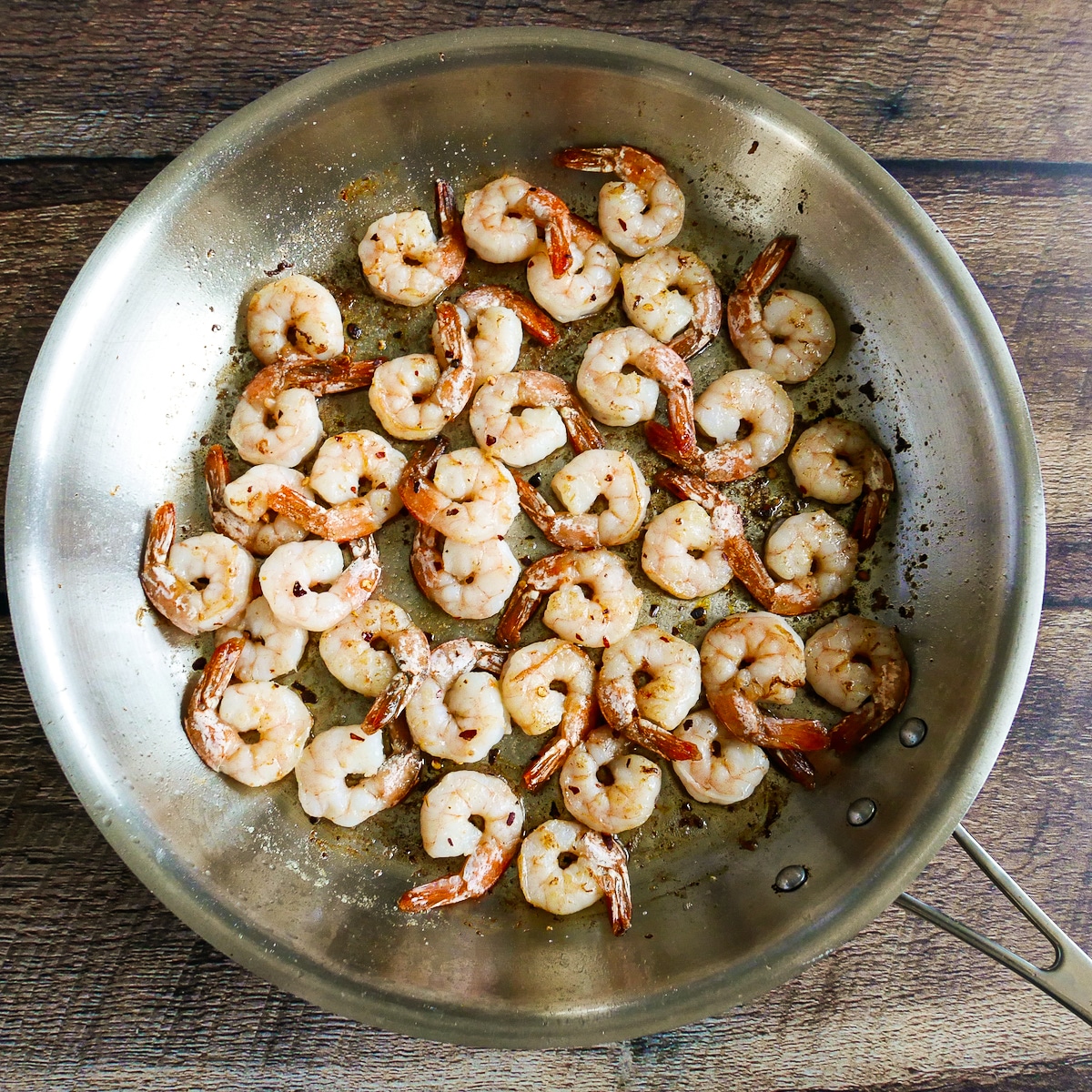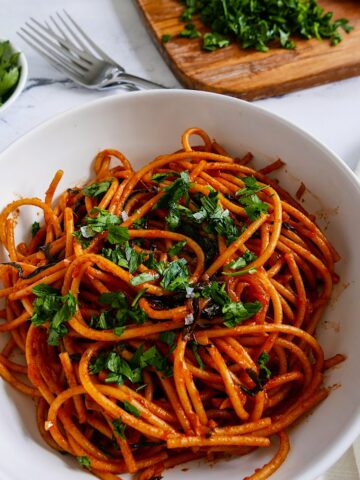In this garlic shrimp spaghetti recipe, succulent shrimp are tossed in a rich and creamy garlic butter sauce and placed on a bed of spaghetti noodles. It feels like a gourmet Italian meal, but it's easy enough for busy weeknights. This delicious shrimp pasta dish is a protein-rich meal that's ready in less than 30 minutes, and it can even be customized for dairy-free or gluten-free folks.

Want to save this recipe?
Enter your email below and get it sent straight to your inbox. Plus, I'll send you easy and delicious recipes every week!
Regular readers know about my love of pasta. Whether you're making pasta with green sauce or scallop pasta, you really can't go wrong.
This rich and buttery shrimp spaghetti falls into the category of "It looks and tastes like it was hard to make but is actually quite easy." Just remember to pat your shrimp dry before cooking to get a nice sear on them. Bon appétit!
Jump to:
⭐️ Why This Garlic and Shrimp Pasta is the Best
- Succulent shrimp are tossed in a rich and creamy garlic butter sauce and placed on a bed of spaghetti noodles
- Feels like a gourmet Italian meal but it's simple enough for busy weeknights
- Quick and easy seafood pasta that's ready in less than 30 minutes
- Garlic shrimp pasta is a protein-rich meal that can be customized for dairy-free or gluten-free folks
🍝 Ingredient Notes

- Spaghetti noodles - Use any long pasta noodles, such as spaghetti, fettuccine, or linguine.
- Unsalted butter - Using unsalted butter lets you control the amount of salt in your cooking.
- Extra-virgin olive oil - I like to use a combination of olive oil and butter when sauteing shrimp due to olive oil having a higher smoking point.
- Large raw shrimp - Use good-quality fresh or frozen large shrimp (31-40 count per lb.) that's been peeled and de-veined. If using frozen shrimp, make sure to thaw it before using.
- Garlic - Using fresh garlic really makes a difference for simple pasta dishes like this one.
- Red pepper flakes - Adds a subtle spicy kick
- Fresh lemon juice - Gives bright acidity to the rich buttery sauce
- Parmesan cheese - For the best melting, make sure that you buy a wedge of fresh Parmesan cheese and not the pre-shredded kind, as the latter does not melt very well.
- Fresh parsley - Adds fresh herby flavor and a pop of color
🌿 Variations & Substitutions
- Shrimp and spinach pasta: Get your daily intake of leafy greens by adding 8 ounces of fresh spinach or 10 ounces of frozen spinach to your pasta.
- Shrimp spaghetti alfredo: Make it a creamy alfredo pasta dish by adding 1 cup of heavy cream after cooking your garlic. Bring to a simmer, and then add Parmesan cheese, lemon juice, pasta water, and cooked spaghetti.
- Make it gluten-free: Substitute gluten-free pasta noodles for a gluten-free meal.
- Dairy-free shrimp with spaghetti: Substitute plant-based butter and Parmesan cheese for a dairy-free meal.
- Make shrimp scampi: Add ½ cup of crisp, dry white wine after cooking your garlic. Cook for 2-3 minutes before adding Parmesan cheese and other remaining ingredients.
🔪 How to Make Shrimp Spaghetti
Over high heat, bring a large pot of (salted) water to a boil. Add spaghetti and cook according to package instructions, stirring occasionally to prevent the noodles from sticking together. After pasta is cooked, set aside ½ cup of pasta water and drain the pasta.

Meanwhile, add butter and olive oil to a large skillet over medium high heat. Pat shrimp dry with a paper towel and add raw shrimp, salt, and red pepper flakes to skillet. Cook for around 2 minutes, stirring occasionally, until shrimp is opaque pink. Transfer shrimp to a plate.

In the same skillet over medium-low heat, add garlic and cook for one minute, until fragrant. Add cooked spaghetti into the skillet, and pour in reserved pasta water, lemon juice, and Parmesan cheese. Use tongs to toss noodles until creamy and coated with sauce.

Place cooked shrimp on top of spaghetti and garnish with fresh parsley. Serve immediately and store in the refrigerator for up to 3 days.

👩🏼🍳 Expert Tips
- Storage: Place in an airtight container and keep in the refrigerator for up to 3 days.
- How to reheat: Place leftovers in a medium skillet with 1-2 tablespoons of water, and heat on medium-low for 5-7 minutes, until heated through.
- Salt your pasta water. As the water is absorbed into the noodles, the salt is absorbed along with it, giving it so much flavor. The ideal ratio for well-seasoned pasta water is ¾ teaspoon sea salt (or table salt) per 1 liter of water.
- Reserve pasta water. Be sure to reserve ½ cup of pasta water before draining. It contains starch, which helps to thicken the sauce and ensures that it sticks to the pasta noodles.
- Cook pasta al dente. Cook your pasta according to package instructions to avoid overcooked, mushy pasta. It should be firm-tender when you bite into it.
- Thaw and dry frozen shrimp. If using frozen shrimp, make sure it's thawed first, then pat it dry with a paper towel before using. This ensures that the shrimp gets seared and not steamed. To easily thaw frozen shrimp, dump the entire bag into a large bowl of cold water for 15 to 20 minutes.
- Don't overcook the shrimp. They only need to be cooked for a few minutes, and should be an opaque pink after cooking. Avoid overcooking your shrimp, which will create a chewy texture.
🥖 What to Serve with Shrimp Spaghetti

Because this is a hearty meal as-is, I recommend pairing it with roasted vegetables, like Brussels sprouts; a piece of crusty bread, like rosemary focaccia; or a side salad, like citrus fennel salad.
💬 Frequently Asked Questions
Yes, always peel and de-vein shrimp before cooking it.
Thaw frozen shrimp and pat dry with a paper towel before using it. Cook according to recipe instructions, usually 2-3 minutes to sear shrimp.
Shrimp scampi sauce is very similar to garlic butter sauce, but usually with the addition of white wine and a shallot.
Cook shrimp separately from pasta to avoid overcooking. Shrimp cooks very quickly because it's a lean protein, so all you need is 2-3 minutes. Then, add to cooked pasta and toss.
Frozen shrimp does not need to be rinsed before using.
🍝 More Pasta Recipes
Tried this recipe? Please leave a star ⭐️⭐️⭐️⭐️⭐️ rating below and/or a review in the comments section further down the page. You can also stay in touch with us through social media by following us on Instagram, Pinterest, TikTok, and Facebook.
Subscribe to my email newsletter to get a FREE e-book of 20 vegetarian recipes, and get new recipes delivered to your inbox every week!

Shrimp Spaghetti Recipe
Equipment
- 1 large saucepan
- 1 large skillet
Ingredients
- 8 ounces spaghetti noodles (or any long pasta)
- 2 Tablespoons unsalted butter
- 2 Tablespoons extra-virgin olive oil
- 1 pound large raw shrimp, peeled and deveined (31-40 count per lb.)
- ½ teaspoon salt
- ½ teaspoon red pepper flakes (optional)
- 4 garlic cloves, minced
- 2 Tablespoons fresh lemon juice
- ¼ cup freshly grated Parmesan cheese
- 2 Tablespoons fresh parsley, chopped (garnish)
Instructions
- Over high heat, bring a large pot of (salted) water to a boil. Add spaghetti and cook according to (al dente) package instructions, stirring occasionally to prevent the noodles from sticking together. After pasta is cooked, set aside ½ cup of pasta water and drain the pasta.
- Meanwhile, add butter and olive oil to a large skillet over medium high heat. Pat shrimp dry with a paper towel and add raw shrimp, salt, and red pepper flakes to the skillet. Cook for around 2 minutes, stirring occasionally and flipping once, until shrimp is opaque pink. Transfer shrimp to a plate.
- In the same skillet over medium-low heat, add garlic and cook for one minute, until fragrant. Add cooked spaghetti into the skillet, and pour in reserved pasta water, lemon juice, and Parmesan cheese. Use tongs to toss noodles until creamy and coated with sauce.
- Place cooked shrimp on top of spaghetti and garnish with fresh parsley. Serve immediately and store in the refrigerator for up to 3 days.
Notes
- Storage: Place in an airtight container and keep in the refrigerator for up to 3 days.
- Salt your pasta water. As the water is absorbed into the noodles, the salt is absorbed along with it, giving it so much flavor. The ideal ratio for well-seasoned pasta water is ¾ teaspoon sea salt (or table salt) per 1 liter of water.
- Reserve pasta water. Be sure to reserve 1 cup of pasta water before draining. It contains starch, which helps to thicken the sauce and ensures that it sticks to the pasta noodles.
- Cook pasta al dente. Cook your pasta according to package instructions to avoid overcooked, mushy pasta. It should be firm-tender when you bite into it.
- Don't overcook the shrimp. They only need to be cooked for a few minutes, and should be an opaque pink after cooking. Avoid overcooking your shrimp, which will create a chewy texture.









Anne L Edwards
Super easy and super good
MaryAnne
Thanks, Anne!